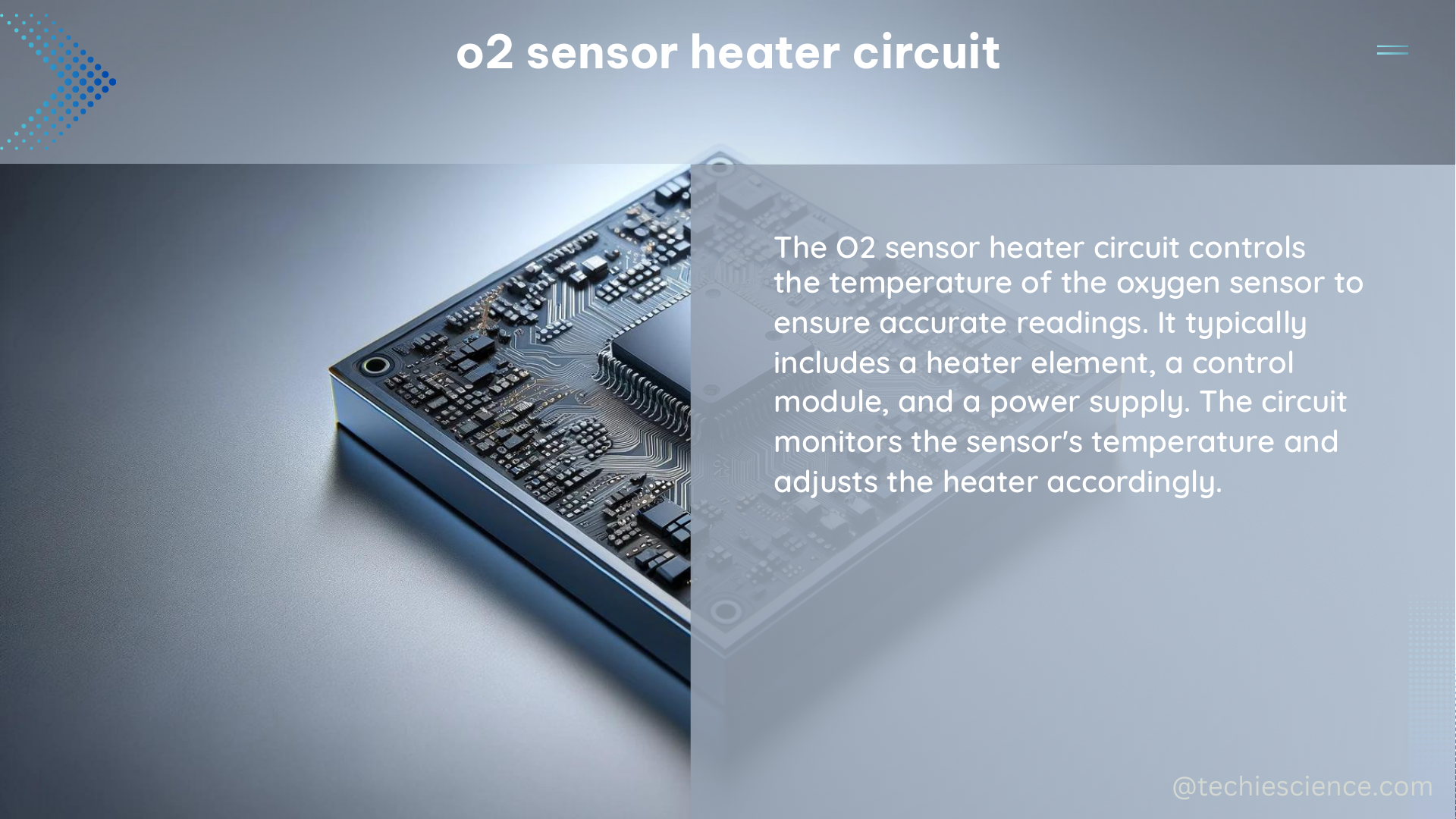The oxygen sensor (O2) heater circuit is a critical component in modern vehicles, responsible for heating the O2 sensor to its operating temperature quickly to ensure accurate emissions monitoring. This comprehensive guide will delve into the intricacies of the O2 sensor heater circuit, providing a detailed understanding of its function, diagnostic procedures, and troubleshooting techniques.
Understanding the O2 Sensor Heater Circuit
The O2 sensor heater circuit typically consists of two wires: one that receives voltage with the key-on through a relay, and another that is controlled by the powertrain control module (PCM) for ground control. This circuit is designed to heat the O2 sensor to its optimal operating temperature, typically between 600°F and 1200°F, to ensure accurate readings of the air-fuel ratio in the exhaust system.
Key Components of the O2 Sensor Heater Circuit
-
O2 Sensor: The oxygen sensor is the primary component in the circuit, responsible for measuring the oxygen content in the exhaust gas. It is equipped with a heating element that is powered by the heater circuit.
-
Powertrain Control Module (PCM): The PCM is the brain of the vehicle’s engine management system, and it controls the operation of the O2 sensor heater circuit. It provides the ground control for the heater element.
-
Relay: The relay is responsible for switching the voltage supply to the O2 sensor heater circuit when the engine is running. It is typically activated by the PCM or the ignition system.
-
Wiring and Connectors: The heater circuit is composed of two dedicated wires that connect the O2 sensor to the PCM and the power source. Proper wiring and secure connections are crucial for the circuit’s functionality.
Measuring the O2 Sensor Heater Circuit
When diagnosing O2 sensor heater circuit failures, technicians often measure the amperage of the heater circuit to confirm the sensor’s heater is working correctly. The resistance of a new O2 sensor heater element typically ranges from 3 to 25 ohms, and measuring this resistance with a multimeter can help determine if the heater element has failed.
It’s essential to consult the specific vehicle’s specifications for the exact resistance levels, as they can vary between manufacturers and models. For example, a Ford O2 sensor heater circuit may have a resistance range of 5-20 ohms, while a Honda O2 sensor heater circuit may have a resistance range of 3-15 ohms.
Diagnosing O2 Sensor Heater Circuit Issues

A faulty O2 sensor heater is the most common cause of P0141 codes, indicating an issue with the heater circuit of the catalytic converter’s downstream oxygen sensor. However, other circuit problems, such as damaged wiring or loose connections, may also cause these trouble codes.
Step-by-Step Diagnostic Procedure
-
Check for Trouble Codes: Start by scanning the vehicle’s onboard diagnostic system for any trouble codes related to the O2 sensor heater circuit, such as P0141.
-
Inspect Wiring and Connectors: Visually inspect the wiring and connectors associated with the O2 sensor heater circuit for any signs of damage, corrosion, or loose connections.
-
Measure Heater Circuit Resistance: Use a multimeter to measure the resistance of the O2 sensor heater element. Compare the measured value to the manufacturer’s specifications to determine if the heater element is within the acceptable range.
-
Verify Voltage and Ground: Check for the presence of voltage at the O2 sensor connector when the engine is running. Ensure that the ground circuit is functioning correctly by measuring the voltage drop across the ground connection.
-
Test Heater Circuit Operation: Activate the O2 sensor heater circuit and measure the current draw. The current draw should be within the manufacturer’s specified range, typically between 0.5 and 3.0 amps.
-
Inspect Fuses and Relays: Check for any blown fuses or malfunctioning relays that may be affecting the O2 sensor heater circuit.
-
Evaluate PCM Operation: In rare cases, software issues within the PCM may contribute to O2 sensor heater circuit problems. Consult the manufacturer’s diagnostic procedures for further evaluation.
Troubleshooting Common O2 Sensor Heater Circuit Issues
-
Heater Element Failure: If the resistance of the O2 sensor heater element is outside the manufacturer’s specified range, the heater element has likely failed and the O2 sensor will need to be replaced.
-
Wiring or Connector Issues: Damaged wiring, loose connections, or corrosion in the O2 sensor heater circuit can cause intermittent or complete circuit failures. Repair or replace the affected components as necessary.
-
Relay or Fuse Problems: A faulty relay or a blown fuse in the O2 sensor heater circuit can prevent the heater from functioning properly. Test and replace these components as needed.
-
PCM Malfunction: Although rare, software issues within the PCM can sometimes contribute to O2 sensor heater circuit problems. In such cases, the PCM may need to be reprogrammed or replaced.
Conclusion
The O2 sensor heater circuit plays a crucial role in ensuring accurate emissions monitoring and maintaining optimal vehicle performance. By understanding the measurable, quantifiable data associated with this circuit, such as resistance values and amperage draw, technicians can effectively diagnose and resolve issues related to P0141 codes and other O2 sensor heater circuit problems.
References:
- Diagnosing O2 Sensor Heater Circuit Failures – MOTOR: https://www.motor.com/magazine-summary/diagnosing-o2-sensor-heater-circuit-failures/
- P0141 Code: Oxygen Sensor Heater Circuit Malfunction (Bank 1 …): https://www.carparts.com/blog/p0141-code-oxygen-sensor-heater-circuit-malfunction-bank-1-sensor-2/
- How To Test Oxygen Sensor Heated Element is Good or Bad (H02S …): https://www.youtube.com/watch?v=CviauEqXTLk
- Oxygen Sensor Heater Circuit Diagnosis and Repair: https://www.aa1car.com/library/oxygen_sensor_heater_circuit.htm
- Troubleshooting O2 Sensor Heater Circuits: https://www.autoshop101.com/forms/h38.pdf

The lambdageeks.com Core SME Team is a group of experienced subject matter experts from diverse scientific and technical fields including Physics, Chemistry, Technology,Electronics & Electrical Engineering, Automotive, Mechanical Engineering. Our team collaborates to create high-quality, well-researched articles on a wide range of science and technology topics for the lambdageeks.com website.
All Our Senior SME are having more than 7 Years of experience in the respective fields . They are either Working Industry Professionals or assocaited With different Universities. Refer Our Authors Page to get to know About our Core SMEs.